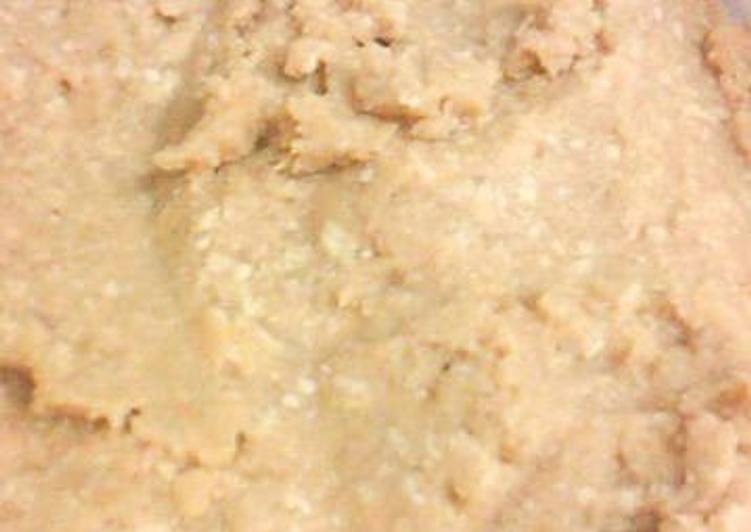
Hey everyone, hope you’re having an amazing day today. Today, I will show you a way to make a distinctive dish, homemade miso made in a plastic storage container (sweet or not so salty version). It is one of my favorites food recipes. This time, I am going to make it a little bit unique. This will be really delicious.
Homemade Miso Made In a Plastic Storage Container (Sweet or Not So Salty Version) is one of the most popular of recent trending meals in the world. It’s simple, it’s quick, it tastes yummy. It’s appreciated by millions every day. They are nice and they look wonderful. Homemade Miso Made In a Plastic Storage Container (Sweet or Not So Salty Version) is something that I’ve loved my whole life.
The Garbanzo beans make a really nice miso. I am an retired Chef and I wanted to make something sweet using miso, so I found one that I think is wonderful. It's a Peanut butter chocolate dipped miso cookie. It's not my recipe so just google it.
To get started with this recipe, we have to first prepare a few components. You can cook homemade miso made in a plastic storage container (sweet or not so salty version) using 3 ingredients and 15 steps. Here is how you can achieve that.
The ingredients needed to make Homemade Miso Made In a Plastic Storage Container (Sweet or Not So Salty Version):
- Prepare 1000 grams Dried soybeans
- Take 1000 grams Rice koji (Seikyo's Yasaka label fresh organic koji)
- Make ready 450 grams Salt (or shima maasu, Okinawan salt)
Once it is made, you can use the amazing fermented paste for many delicious Japanese dishes! This article will tell you an easy way to make miso using miso's fermentation/culture starter called koji (malt; Aspergillus oryzae). There also a recipe for miso soup! Let's try to make delicious organic miso at home!
Instructions to make Homemade Miso Made In a Plastic Storage Container (Sweet or Not So Salty Version):
- Wash the soybeans, and soak in plenty of water overnight.
- Drain off the soaking water, and boil the soybeans in fresh water. Cook them slowly over medium-low heat for about 5 hours. Be careful not to let them burn.
- Bubbles will rise to the surface as they cook so skim them off. Add water to the pot to cover the beans if the water level drops too low.
- When the soybeans are soft they are done. You should be able to crush one easily between the thumb and forefinger of your opposite hand (your left hand if you're right handed).
- Reserve 2 handfuls of the salt in a separate container. Mix the rest of the salt with the koji while breaking up the clumps with your hands. (The koji in the background has been mixed with salt.)
- Spray a bowl or other container with 70% ethanol. Add the slightly cooled soy beans and mash them up using a potato masher. If a few bits of soybean are still left, it's fine.
- Spray both hands with 60% ethanol, then mix the salt-koji and the mashed soybeans together well.
- Add some of the soybean cooking liquid until the mixture is soft and dough-like, with a texture similar to how your earlobe feels. Form it into baseball-sized balls (these are called miso balls), as if you were making onigiri rice balls.
- Spray a plastic storage box with 70% ethanol, and wipe it dry with a clean paper towel. Cover the bottom with some of the salt that was reserved in Step 5. (Leave some salt to sprinkle on top of the miso.)
- Push the miso balls into the bottom of the plastic box so that there are no gaps. I don't throw the balls in. (Translator's note: some miso instructions say to throw the miso balls into the container to eliminate air pockets.) Verify that there are no air pockets by observing the miso from the outside of the box.
- When all the miso balls are packed in, sprinkle all the remaining salt on top.
- Spray the surface of the miso with 70% ethanol, and cover with plastic wrap. Spray again with ethanol and add another layer of plastic wrap.
- Wipe off any soy beans that are stuck to the sides of the container, spray with more ethanol and put the lid on. Wrap in newspaper.
- Store in a cool dark place. Open it up in about 5 months to check on it. Mix it up from the bottom with a clean paddle.
- It's ready to eat in 6 to 10 months.
There also a recipe for miso soup! Let's try to make delicious organic miso at home! White miso is less salty than brown or red, so while I wouldn't pile on other salty ingredients without tasting, I also wouldn't worry too much about its inherent saltiness. Here's a recipe for baked miso-glazed salmon using white miso and mirin (if you don't have sake you could sub Chinese rice wine or dry sherry if you have either): http. Miso is a ferment, and in a very controlled environment, you could make a lower-salt version.
So that’s going to wrap this up with this special food homemade miso made in a plastic storage container (sweet or not so salty version) recipe. Thank you very much for your time. I am confident that you will make this at home. There’s gonna be interesting food in home recipes coming up. Remember to save this page in your browser, and share it to your family, colleague and friends. Thanks again for reading. Go on get cooking!

